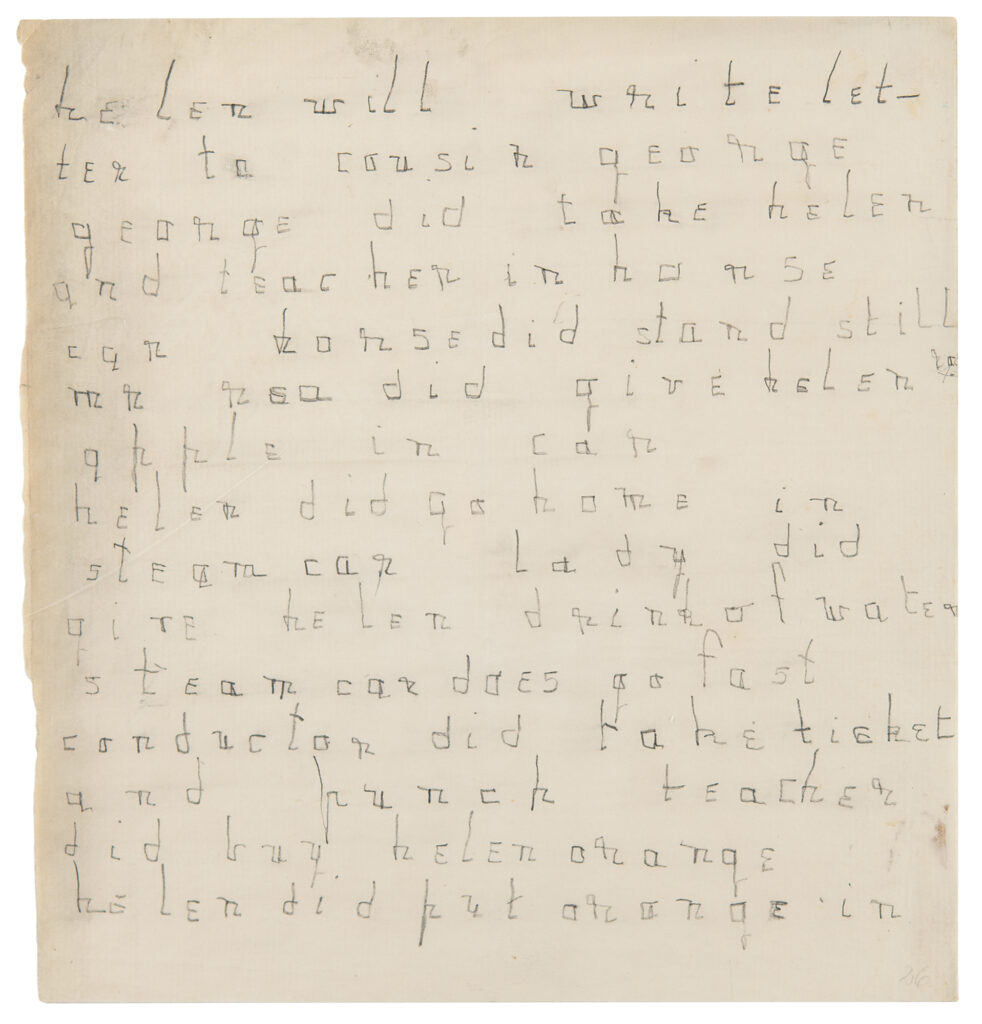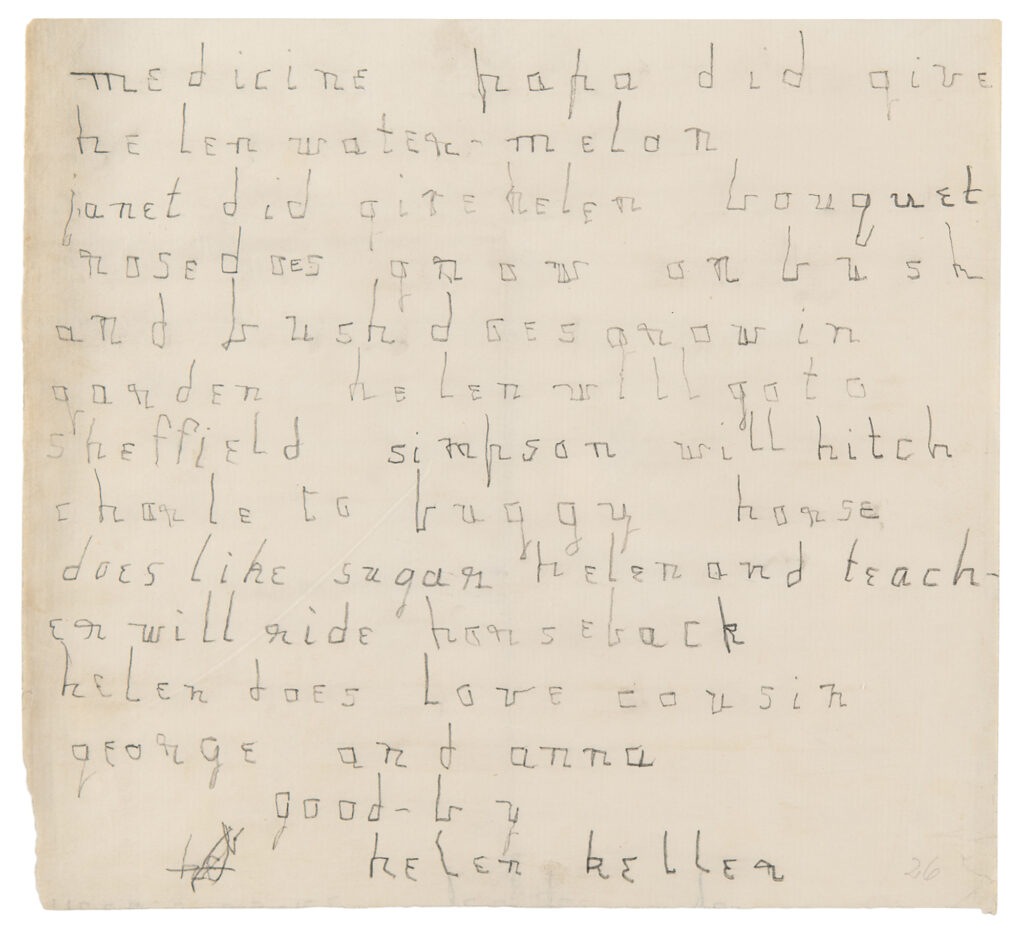by Brooke Kennedy
Around this time, kids and parents are hustling to get ready for the beginning of the school year. Bags packed and ready to go, children are shuttled off to fill their minds with facts and figures of notables in every field. But those famous names written on whiteboards are not just research subjects for student papers. In the auction world, those names present enormous value, piquing the interest of collectors and historians alike.
History
When Helen Keller, left blind and deaf by an early childhood illness, met her “Teacher” Anne Sullivan, it began a lifelong mentorship that would cause Keller to make history. Under Sullivan’s teachings, she quickly learned the alphabet and before long started writing. Her early letters document her progress, describing her everyday experiences – just a stepping stone onto her path to becoming a lecturer and advocate.


Writing to “cousin George,” in circa 1887 she said, “George did take Helen and teacher in horse car horse did stand still…Helen did go home in steam car lady did give Helen drink of water steam car does go fasts conductor did take ticket and punch teacher did buy Helen orange Helen did put orange in medicine Papa did give Helen watermelon. Janet did give Helen bouquet Rose does grow on bush and bush does grow in garden Helen will go to Sheffield Simpson will hitch Charle to buggy horse does like sugar Helen and teacher will ride horseback. Helen does love cousin George and Anna.” The aforementioned George is Lieutenant George Pendleton Turner, husband to Keller’s cousin Anna S. Keller Turner.
Keller’s education with Sullivan consisted of touch to help Keller learn the alphabet and spell out words. Soon Keller was enrolled at the Perkins School for the Blind and later the Cambridge School for Young Ladies. With her stellar progress in her communication studies, her story spread among the general public, including a new acquaintance (and later friend), writer Mark Twain. Twain, who was so impressed with her advancement, had her education financed by his friend Henry Rogers.1
English
When saddled with summer reading, classics often find their way onto student lists and teaching itineraries. While some abandon their lists at the bottom of backpacks, those who pick up classic novels sometimes find inspiration, humor, and thought-provoking motifs. But hardly seen are the writers who put their words to the page.
Collectors, however, have been lucky. Photos of famous scribes have been popping up at auction for quite some time, including a cabinet photo of Samuel L. Clemens, better known as Mark Twain. Clemens even signs and inscribes the photo in the lower border, “Very truly yours, Mark Twain, To Miss Stickney, March 10/06.”
According to RR Auction’s description, “Augustus Allen Stickney (1833-1880) was a San Francisco publisher of the newspaper ‘The Californian,’ and as such became friends with Mark Twain, Henry George, and Bret Harte who was also editor of the newspaper. Mark Twain was hired to contribute one article per week, receiving $50 per month for his contributions. In total, Twain contributed approximately fifty articles that appeared in The Californian, several of which were collected and published in 1867 in The Celebrated Jumping Frog of Calaveras County, and Other Sketches- Mark Twain’s first published book. Presumably, this photograph was inscribed to Augustus’ wife, Belzora Ross Stickney (nee Clark).”
It would be another sixteen years before Twain would publish one of his best-known works of fiction. The Adventures of Huckleberry Finn was published in 1885 and serves as a direct sequel to The Adventures of Tom Sawyer. Since its release, the book has been described as one of the Great American novels and sees frequent studies by literary critics and students alike.2 First edition books of any classic are highly sought after, and this photo comes with a first American edition of Tom Sawyer’s sequel.
Mathematics
During math class, students have three methods to solve their equations: mental math, pencil and paper, and the trusty calculator. Both amateurs and geniuses have their own preferences, but some take a slightly different approach. For Einstein, he found his “human calculator” in Walther Mayer, who would become his mathematician assistant.
In a snippet from a 1936 letter to Mayer, Einstein gives readers a look into his working process, “I believe I see a new possibility, which promises success. It is along the lines of the recently devised way, according to which one places zero on the right side of the Dirac-Equations. The novelty is in the fact that the constants a1…a4 (aside from a totally irrelevant factor) are completely known without passing on to the specific Semi-Vectors. After omission of the φ-terms, the equations read [mathematical equations]. Or, for De-Broglie-Equations of the restless particle: [mathematical equations].”
Austrian mathematician Walther Mayer began working with Einstein around 1930, the year the two submitted a paper to the Prussian Academy. In it, a new unified field theory was proposed, one based on a four-dimensional space-time continuum with a five-dimensional tangent space attached at each point. From December 1930 to March 1931, Einstein made his first trip to California with Mayer accompanying him, since Einstein did not wish to interrupt the collaboration. The two would work on several more papers together, and Einstein would eventually recommend Mayer receive tenure at The Institute for Advanced Study in Princeton, New Jersey.
Einstein’s collaboration with Walther Mayer was brief, as Mayer would return to his original pursuit of pure mathematics. But their partnership proved that even the greatest minds sometimes need help from their peers.
Instead of the classroom, all three items will be going to the auction block. RR Auction’s monthly Fine Autographs and Artifacts auction and annual event – Remarkable Rarities – will be featuring them. Bidding is now open on all lots. The Keller letter and Twain photo close on September 11, 2024 and the Einstein lot will be auctioned in Rarities, which takes place live on September 28, 2024.
Footnotes
- Debra Michals, PhD, “Helen Keller,” National Women’s History Museum. Last updated 2015. https://www.womenshistory.org/education-resources/biographies/helen-keller. ↩︎
- “Mark Twain publishes ‘The Adventures of Huckleberry Finn,’” History. Last updated Feb. 26, 2024. https://www.history.com/this-day-in-history/twain-publishes-the-adventures-of-huckleberry-finn. ↩︎


